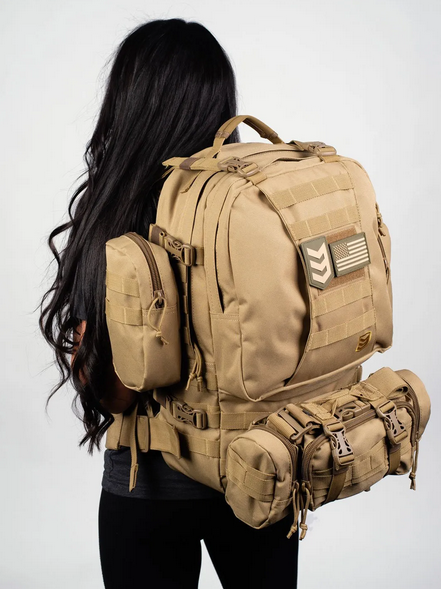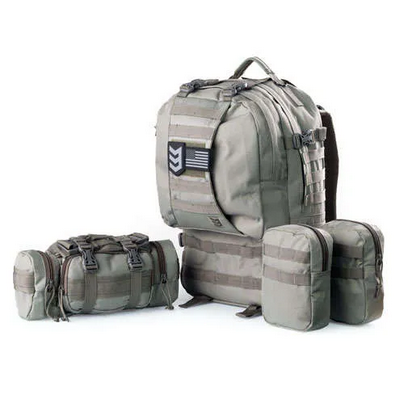By Lee Williams
SAF Investigative Journalism Project
(Editor’s Note: Lee Williams is a military veteran and former law enforcement officer with keen survival skills. He first published this article in October 2021, and revived it this week in the aftermath of the massive and dangerous train derailment in East Palestine, Ohio. Are you prepared for a disaster? )
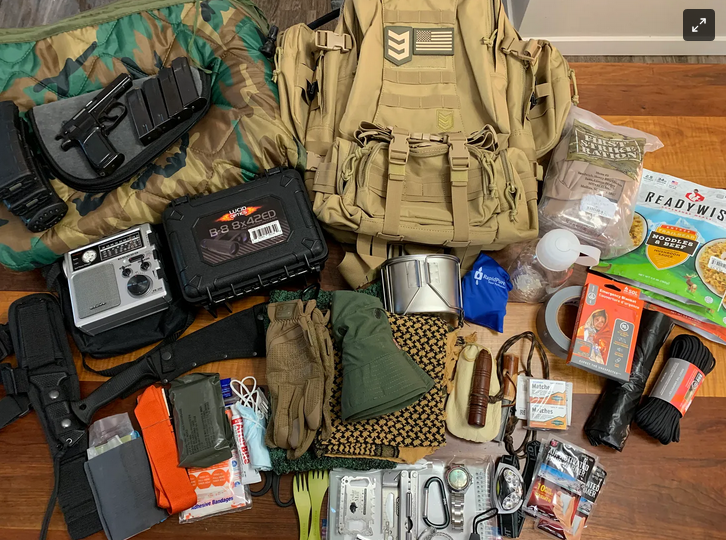
A train derails near your home releasing a cloud of toxic gas. You have minutes, if not seconds, to grab what you need to survive and flee.
An F5 tornado is headed straight for your home like a freight train. Sheltering in place is not an option. You have seconds to decide what to take with you, knowing you will be on your own for days.
Rioters are burning down your city. Your home could be next. You need to evacuate immediately and make your way through a crowd of violent rioters. Police are nowhere to be seen.
And then of course there are the zombies …
A good bug-out bag – also known as a SHTF bag or Go bag – can save your life in any of these emergency situations, assuming it’s stocked with what you need and you know how to use it.
While there is a lot of advice out there, in my humble opinion a bug-out bag should be able to keep you alive for a minimum of 72 hours – 84 hours if you push it. It should have redundant systems for water purification, food, shelter, fire starting, First Aid, communication and of course self-defense.
There are plenty of pre-stocked bug-out bags on the market. Some are great. Some leave a lot to be desired, because the manufacturers skimp on the contents to maximize their profits. At best, these one-size-fits-all kits are never as good as something you can put together yourself. They don’t take into account climate, terrain and other factors, which are important for the end user to consider. For example, your survival needs during a muggy Florida summer differ greatly from what you’ll need during a snow storm in the Midwest.
Training
If you’ve never tried to purify water, stop a bleed or start a fire with a ferro rod, it’s not easy, especially when you’re shaking from cold, adrenaline and fear. It’s best to train now before an actual emergency occurs. Go camping off-grid or take a wilderness survival course. They’re fun and you will learn how to use your survival gear the right way, but you will also learn what you don’t need to drag along. I strongly recommend taking a Tac-Med course too. Knowing how to stop a bleed is a vital lifetime skill. Our friends at the D-Dey Response Group have the best Tac-Med course available. They’re all former 18-Deltas – Special Forces medical sergeants who have saved lives on the battlefield.
The Bag
I chose the Paratus 3-Day Operator’s Backpack by 3V Gear for my bug-out bag, and the good folks at 3V Gear were kind enough to ship one for this story. Cost was a major factor for my decision, and the Paratus has an MSRP of $84.95, which is considerably less than its competitors. It’s 3V Gear’s most popular pack.
The Paratus is modular – and this flexibility has made it a popular choice especially for bug-out bags. There are two MOLLE accessory pouches that attach to the sides of the main pack, but it was the “rapid deployment pack” that I liked most. This small pack can be detached and worn slung over the shoulder or as a fanny pack. Since redundancy rules in a survival situation, I turned the rapid deployment pack into a mini bug-out bag. It contains all of the systems in the bigger pack – water purification, food, shelter, fire starting, First Aid, communication and defense – on a smaller scale. Therefore, if I ever need to drop the larger pack the smaller one can still meet basic needs.
The Paratus is festooned with MOLLE, cargo straps and multiple tie-down and adjustment points, so you can secure your equipment without worrying about leaving a “garage sale” of fallen gear in your wake. It’s also roomy: 20-inches tall, 12-inches wide and 8.5-inches deep, but it only weighs 4.45 pounds. It is water resistant and well-padded for extended use. I strongly recommend this product. You won’t find a better pack for the price.
My bug-out bag is designed for a temperate climate, 50-degrees and up. It’s not a cold-weather kit. There are a lot of gear lists out there, which you should research before you build your own, but this list is what works for me. As you will see, there’s an emphasis on redundancy and versatility.
Hydration
- Camelbak
- Nalgene water bottle
- Water purification straw
- Water purification pills
- Bleach, two-ounce bottle – 8-12 drops of bleach will purify one gallon of water.
- Canteen cup
- Sports drink mix, six packets, to mask the taste of purified water
- Coffee filters – for straining particles from cloudy water before purifying
· Food
- First Strike ration – ready to eat
- Mountain House main courses, dehydrated, four
- Clif Bars, 12
- Sporks
- Tabasco
- Salt and pepper packets
- Aluminum pot with wire handle
- Pictures of edible plants in my area, printed in color.
· Shelter
- Poncho
- Poncho liner – perhaps the best piece of gear ever issued by the military.
- Black trash bags, one of the most versatile items, used for field-expedient shelters, rain gear, water containers, water purifiers and more.
- Emergency blanket
- Paracord
- Duct tape
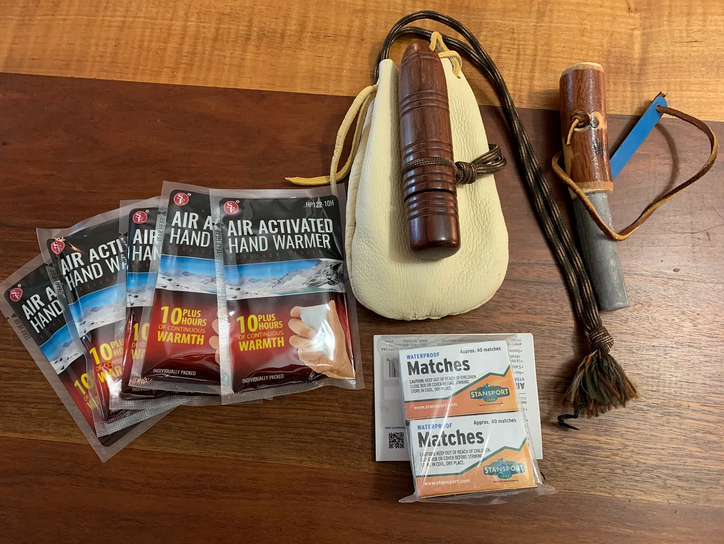
· Fire starting
- Disposable lighters
- Waterproof matches, two boxes
- Fire piston – a traditional fire starter
- Ferro rod and striker
- Fresnel lens – a flexible magnifier about the size of a credit card
- Hand warmers – mandatory, since your fingers lose dexterity when they’re cold, which makes it difficult to perform precise tasks like fire starting.
· Clothing
- Gloves, uninsulated
- Socks, t-shirts and underwear
- Stowable rain suit
- Shemagh – incredibly versatile, can be used as a sling, belt, hat, field-expedient dressing and more
- British sniper veil – another versatile piece of kit. Uses range from camo and shade to netting fish.
- Boonie hat
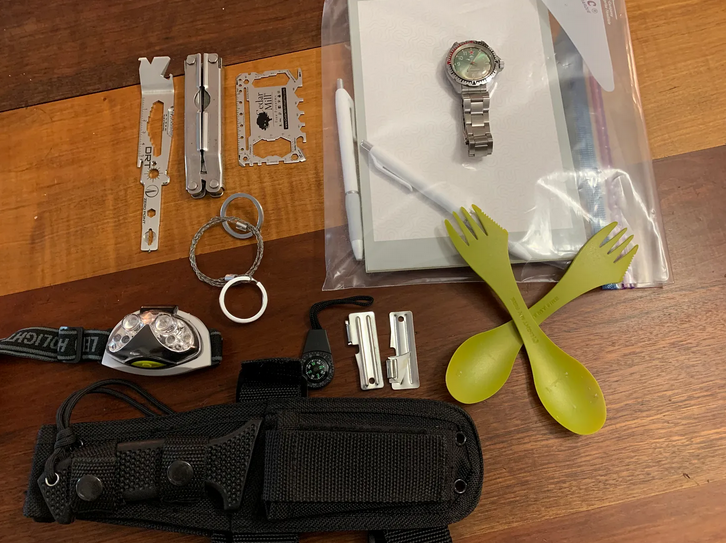
· Tools
- Multitools – one Leatherman and two other one-piece models
- P38 can openers, two
- Sheath knife with sharpening stone
- Machete
- Headlamp, variable power settings of white and red light, strobe
- Compasses, two
- Wire saw
- Tin foil – a thousand uses
· First Aid
- IFAK
- Extra field dressings
- Band-Aid pack
- Extra tourniquet
- Antibiotic cream, two vials
- Bug repellent with DEET
- After-Bite cream
- Chapstick
- Motrin
- Moleskin padding
- Sunscreen, 50 SPF
- EMT Shears
· Communications
- Survival radio – it can be charged with a plug-in, a hand-cranked dynamo or batteries. It can charge a cellphone and has a built-in light. It can receive AM/FM/TV and emergency weather channels.
- Powerpack, good for three cell phone charges
- USB charging cables and plug-ins for cell phone
- Signal mirror
- Orange smoke signals, two
- Orange signal panel, 10”x36”
· Defense
- AR magazines
- EDC handgun magazines
- Spare handgun with IWB holster and five loaded magazines
- Extra batteries for EOTECH sight and weapon lights
- Rifle and Pistol cleaning kit
- OC spray, great for aggressive dogs, bears or other varmints
· Other items
- Sunglasses
- Thumb drive with copies of medical, insurance and other important information.
- Lucid Optics B8 8×42 Binoculars
- $200 in $20-dollar bills
- Fishing kit: 50 yards of 20-pound braided Spectra fishing line, steel leaders, hooks, weights
- Notebooks –for fire tinder, notes and leaving messages
- Pens, two
- Manual wristwatch – my Apple watch dies after 24 hours without a charge
- Kleenex packs
- Wet wipes
- 12-hour candles
Attitude
A positive mental attitude – the will to survive – is the most important survival item. You won’t find it in a store, and you can’t order it off of Amazon, but you will not survive without it.

